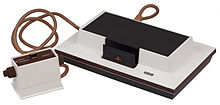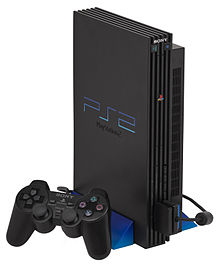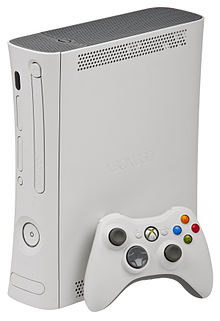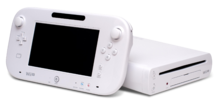
Video game console
Did you know...
SOS Children made this Wikipedia selection alongside other schools resources. See http://www.soschildren.org/sponsor-a-child to find out about child sponsorship.
A video game console is an interactive entertainment computer or customized computer system that produces a video display signal which can be used with a display device (a television, monitor, etc.) to display a video game. The term "video game console" is used to distinguish a machine designed for people to buy and use primarily for playing video games on a TV in contrast to arcade machines, handheld game consoles, or home computers.
As of 2007, it is estimated that video game consoles represent 25% of the world's general-purpose computational power. They have been banned in China since June 2000.
History
First generation
Although the first video games appeared in the 1950s, they were played on vector displays connected to massive computers, not analog televisions. Ralph H. Baer conceived the idea of a home video game in 1951. In the 1960's he created a working video game console at Sanders Associates, but struggled for years to find a television manufacturer willing to produce the console.
Finally, in 1972 Magnavox released the Magnavox Odyssey, the first home video game console which could be connected to a TV set. Ralph Baer's initial design had called for a huge row of switches that would allow gamers to turn on and off certain components of the console (the Odyssey lacked a cpu) to create slightly different games like tennis, volleyball, hockey, and chase. Magnavox replaced the switch design with separate cartridges for each game. Although Baer had sketched up ideas for cartridges that could include new components for new games, the carts released by Magnavox all served the same function as the switches and allowed gamers to choose from the Odyssey's built in games.
The Odyssey was initially only moderately successful, and it was not until Atari's arcade game Pong popularized video games, that the public began to take more notice of the emerging industry. By the autumn of 1975 Magnavox, bowing to the popularity of Pong, cancelled the Odyssey and released a scaled down version that played only Pong and hockey, the Odyssey 100. A second, "higher end" console, the Odyssey 200, was released with the 100 and added onscreen scoring, up to four players, and a third game—Smash. Almost simultaneously released with Atari's own home Pong console through Sears, these consoles jump-started the consumer market. All three of the new consoles used simpler designs than the original Odyssey with no board game pieces or extra cartridges.
In the years that followed, the market saw a multitude of companies rushing similar consoles to market. After General Instrument released their inexpensive microchips, each containing a complete console on a single chip, many small developers began releasing consoles that looked different externally, but internally were playing exactly the same games.
The consoles from this era were mostly dedicated consoles playing only the games that came with the console. These video game consoles were often just called video games, because their was little reason to distinguish the two yet. While a few companies like Atari, Magnavox, and newcomer Coleco pushed the envelope, the market became flooded with simple, similar video games.
Second generation
Fairchild released the Fairchild Video Entertainment System (VES) in 1976. While there had been previous game consoles that used cartridges, either the cartridges had no information and served the same function as flipping switches (the Odyssey) or the console itself was empty and the cartridge contained all of the game components. The VES, however, contained a programmable microprocessor so its cartridges only needed a single ROM chip to store microprocessor instructions.
RCA and Atari soon released their own cartridge-based consoles.
Video game crash of 1977
In 1977, manufacturers of older, obsolete consoles and Pong clones sold their systems at a loss to clear stock, creating a glut in the market, and causing RCA and later Fairchild to abandon their game consoles. Only Atari and Magnavox remained in the home console market, despite suffering losses in 1977 and 1978.
Rebirth of the home console market
Initially, VES continued to be sold at a profit after the 1977 crash, and both Bally (with their Home Library Computer in 1977) and Magnavox (with the Odyssey² in 1978) brought their own programmable cartridge-based consoles to the market. However, it was not until Atari released a conversion of the arcade hit Space Invaders in 1980 that the home console industry was completely revived. Many consumers bought an Atari console so they could play Space Invaders at home. Space Invaders' unprecedented success started the trend of console manufacturers trying to get exclusive rights to arcade titles, and the trend of advertisements for game consoles claiming to bring the arcade experience home.
Throughout the early 1980s, other companies released video game consoles of their own. Many of the video game systems were technically superior to the Atari 2600, and marketed as improvements over the Atari 2600. However, Atari dominated the console market in the early 1980s.
Video game crash of 1983
In 1983, the video game business suffered a much more severe crash. A flood of consoles, low quality video games by smaller companies (especially for the 2600), industry leader Atari hyping games such as E.T. and a 2600 Pac-man that were poorly received, and a growing number of home computer users caused consumers and retailers to lose faith and interest in video game consoles. Most video game companies filed for bankruptcy, or moved into other industries, abandoning their game consoles. Mattel Electronics sold the rights for its Intellivision system to the INTV Corporation, who continued to produce Intellivision consoles and develop new games for the Intellivision until 1991. All other North American game consoles were discontinued by 1984.
Third generation
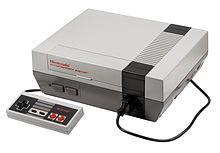
In 1983, Nintendo released the Family Computer (or Famicom) in Japan. Like the ColecoVision, the Famicom supported high-resolution sprites and tiled backgrounds, but with more colors. This allowed Famicom games to be longer and have more detailed graphics. Nintendo brought their Famicom to the U.S. in the form of the Nintendo Entertainment System (NES) after the video game market had crashed. In the U.S., video games were seen as a fad that had already passed. To distinguish its product from older game consoles, Nintendo used a front-loading cartridge port similar to a VCR on the NES, sold the NES with a plastic " robot" ( R.O.B., and initially advertised it as a toy.
The NES was the highest selling console in the history of North America and revitalized the video game market. Mario of Super Mario Bros became a global icon from his NES games. Nintendo took an unusual stance with third-party developers for its console. Nintendo restricted third-party developers to three NES titles per year and forbade them from developing for other video game consoles. The practice ensured Nintendo's market dominance and prevented the flood of trash titles that had helped kill the Atari, but was ruled illegal late in the console's life cycle.
Sega's Master System was intended to compete with the NES, but never gained any significant market share in the US or Japan and was barely profitable. It fared notably better in PAL territories. In Europe and South America, the Master System competed with the NES and saw new game releases even after Sega's next-generation Mega Drive was released. In Brazil where strict importation laws and rampant piracy kept out competitors, the Master System outsold the NES by a massive margin and remained popular into the '90s.
Jack Tramiel, after buying the smoldering wreckage of Atari, downsizing its staff, and settling its legal disputes, attempted to bring Atari back into the home console market. Atari released a smaller, sleeker, cheaper version of their popular Atari 2600. They also released the Atari 7800, a console technologically on par with NES and backwards compatible with the 2600. Finally Atari repackaged its 8-bit XE home computer as the XEGS game console. The new consoles helped Atari claw its way out of debt, but failed to gain much market share from Nintendo. Atari's lack of funds meant that its consoles saw fewer releases, lower production values (both the manuals and the game labels were frequently black and white), and limited distribution.
| Japan | North America | Europe | |
|---|---|---|---|
| Famicom/NES | 1983 | 1985 | 1986 |
| Sega Master System | 1985 | 1986 | 1987 |
| Atari 7800 | none | 1986 | 1987 |
| Atari XEGS | none | 1987 | 1987 |
Fourth generation
Sega gained market share by releasing its next-generation console, the Mega Drive in 1988 in Japan, 1989 in US (where it was branded the Genesis), and 1990 in Europe, two years before Nintendo released the Super Nintendo Entertainment System (SNES) in those territories. While initially sales of the next generation console were slow, Sega found its own must-have hit in Sonic the Hedgehog. Similar to Space Invaders for the Atari, sales spiked after its release.
Nintendo executives were initially reluctant to design a new system, but as the market transitioned to the newer hardware like the Megadrive and NEC's TurboGrafx-16, Nintendo saw the erosion of the commanding market share it had built up with the Famicom and NES. Nintendo's fourth-generation console, the Super Famicom, was released in Japan on November 21, 1990; Nintendo's initial shipment of 300,000 units sold out within hours. The machine reached North America on August 23, 1991, and Europe and Australia in April 1992.
SNK Playmore also released a fourth generation console, the Neo Geo AES. SNK's console was able to play the exact same arcade games as its Neo Geo MVS arcade machines, but a steep price kept its sales low.
Fifth generation
The first fifth-generation consoles were the 3DO and the Atari Jaguar. Both of these systems were much more powerful than the Super Nintendo Entertainment System (SNES) or Mega Drive (known as Genesis in North America); they were better at rendering polygons, could display more onscreen colours, and the 3DO used discs that contained far more information than cartridges and were cheaper to produce. Neither of these consoles were serious threats to Sega or Nintendo, though. The 3DO cost more than the SNES and Genesis combined, and the Jaguar was extremely difficult to program for, leading to a lack of games that used its extra power. Both consoles would be discontinued in 1996. Bandai introduced an Apple Macintosh based console called the Apple Bandai Pippin that was more like a low cost computer than a high end console. The concept did poorly in the marketplace.
To compete with emerging next gen console, Nintendo released games like Donkey Kong Country that could display a wide range of tones (something common in fifth-generation games) by limiting the number of hues onscreen, and games like Star Fox that used an extra chip inside of the cartridge to display polygon graphics. Sega followed suit, releasing Vectorman and Virtua Racing (the latter of which used the Sega Virtua Processor).
It was not until Sega's Saturn, Sony's PlayStation, and the Nintendo 64 were released that fifth generation consoles started to become popular. The Saturn and PlayStation used CDs to store games, while the N64 used cartridges. All three cost far less than the 3DO, and were easier to program than the Jaguar. The Saturn also had 2D sprite handling power on par with the Neo-Geo.
- The 3DO was released in North America in October 4, 1993 and in Japan on March 20, 1994. Although released to much fanfare, like the Jaguar, it faded out of the market with little popularity. The system was technically superior to all the consoles released at the time, but due to the oversaturated market and the hefty US$699.95 price tag, the system did not adopt well into the market. One unique aspect of the 3DO is that the rights to manufacturing the console itself were licensed to different manufacturers by the 3DO company, which only produced the specifications. These companies, in turn, released their own different styles of the same console.
- Atari's Jaguar was released to combat the dominance that Nintendo and Sega were fighting for. Atari's hope was that by designing a more powerful console, it would be able to leapfrog all of the released systems of the day and give gamers a technologically superior system. The Jaguar eventually faded away due to a number of reasons. For example, it was difficult to program, thus making it too problematic to have good third-party support. Another of the Jaguar's pitfalls was the dominance of the previously popular systems. In 1995, the releases of the Sega Saturn and the PlayStation brought the end for the Jaguar. The failure of the Jaguar put Atari into a poor financial situation and forced it to reverse merge with JTS Inc., a short-lived maker of hard disk drives, to form JTS Corporation. The merger effectively ended the company, which existed as a small department for minor support of the Jaguar and the selling off of Atari's intellectual properties.
- The Sega Saturn was released in Japan on November 22, 1994, in North America on May 11, 1995 and in Europe on July 8, 1995. It was the first Sega console to use a CD-ROM based media by default and used a special dual chip processor. The two chips were difficult to program in parallel, required the use of assembly language to harness their power, and suffered from bottleneck issues. The difficulty to program for Saturn was a factor in the console's demise, as it limited third party releases. The Saturn was a mild success in Japan where gamers bought the console to play Virtua Fighter, but was overshadowed by Sony and Nintendo's dominance of the market. The Saturn was discontinued in 1998 with the release of Sega's last console, the Dreamcast.
- Sony's PlayStation was released in Japan on December 3, 1994, in North America on September 9, 1995, in Europe on September 29, 1995 and in Australia on November 15, 1995. The PlayStation was the eventual result of a breakdown of a business partnership plan between Sony and Nintendo to create a CD add-on for the SNES. Nintendo went back on the deal and went to Philips (eventually resulting in the Philips CDi); however, with the project nearing completion, Sony took what it had learned and created a next-gen Sony branded console. The Playstation was able to assemble a tremendous amount of third party developers because of its inexpensive compact discs, Sony's easy to develop with C libraries, and eventually its massive market share. The PlayStation spawned a whole lineup of consoles from generation to generation and has earned Sony great respect as a video game company, becoming the first video game system to sell over 100 million consoles. For the fifth generation Sony used Crash Bandicoot as their mascot to compete with Nintendo. Sony released a redesigned, smaller version of the PlayStation entitled the 'PSone' on July 7, 2000.
- The Nintendo 64 was released in Japan on June 23, 1996, in North America on September 29, 1996 and in Europe and Australia on March 1, 1997. Unlike the other companies' consoles of the generation, the N64 had continued to use ROM cartridges, which many devlopers saw as a hindrance to, because cartridges have much less memory space and are also far more expensive than optical media; however, Nintendo's answer to this was that unlike CDs, cartridges cannot be damaged by a simple scratch to the surface, load times are not much of an issue, and save data can be stored on the cartridge rather than on a memory card.
Sixth generation
The sixth generation saw a move towards PC-like architectures in gaming consoles, as well as a shift towards using DVDs for game media. This brought games that were both longer and more visually appealing. Furthermore, this generation also saw experimentation with online console gaming and implementing both flash and hard drive storage for game data.
- Sega's Dreamcast was released in Japan on November 27, 1998, in North America on September 9, 1999, in Europe on October 14, 1999 and in Australia on November 30, 1999. It was the company's last video game console, and was the first of the generation's consoles to be discontinued. Sega implemented a special type of optical media called the GD-ROM. These discs were created in order to prevent software piracy, which had been more easily done with consoles of the previous generation; however, this format was soon cracked as well. It also sported a 33.6Kb or 56k modem which could be used to access the internet or play some of the games, like Phantasy Star Online, online. The Dreamcast was discontinued in March 2001, and Sega transitioned to software developing/publishing only.
- Sony's PlayStation 2 was released in Japan on March 4, 2000, in North America on October 26, 2000, in Europe on November 24, 2000 and in Australia on November 30, 2000. It was the follow-up to its highly successful PlayStation, and was also the first home game console to be able to play DVDs. As was done with the original PlayStation in 2000, Sony redesigned the console in 2004 into a smaller version. As of November 21, 2011 over 150 million PlayStation 2 units have been sold. This makes it the best selling home console of all time to date, and now the second best-selling video game console to date.
- Nintendo's GameCube was released in Japan on September 15, 2001, in North America on November 18, 2001, in Europe on May 3, 2002 and in Australia on May 17, 2002. It was Nintendo's fourth home video game console and the first console by the company to use optical media instead of cartridges. The Nintendo GameCube did not play standard 12 cm DVDs, instead it employed smaller 8 cm optical discs. With the release of the Gamecube Game Boy Player, all Game Boy, Game Boy Colour, and Game Boy Advance cartridges could be played on the platform. The Nintendo Gamecube was discontinued in 2007 with the release of Wii.
- Microsoft released their first games console, the Xbox in North America on November 15, 2001, in Japan on February 22, 2002, and in Europe and Australia on March 14, 2002. It was the first console to employ a hard drive right out of the box to save games, the first to include an Ethernet port for broadband internet, and the beginning of Microsoft's online Xbox LIVE service. Microsoft was able to attract many PC developers by using the NT kernel and Direct X from their Windows operating system. Though criticized for its bulky size and the awkwardness of its original controller, the Xbox eventually gained popularity, especially in the US, due in part to the success of the Halo franchise.
Seventh generation
The features introduced in this generation include the support of new disc formats: Blu-ray Disc, utilized by the PlayStation 3, and HD DVD supported by the Xbox 360 via an optional $200 external accessory addition, that was later discontinued as the format war closed. Another new technology is the use of motion as input, and IR tracking (as implemented on the Wii). Also, all seventh generation consoles support wireless controllers. This generation also introduces the Nintendo DS, and the Nintendo DSi, which add touch screens and cameras to portable gaming.
- Microsoft kicked off the seventh generation with the release of the Xbox 360 released on November 22, 2005 in the United States, December 2, 2005 in Europe, December 10, 2005 in Japan and March 23, 2006 in Australia. It featured market leading processing power until the Sony PlayStation 3 was released one year later. While the original Xbox 360 "Core" did not include an internal HDD, most Xbox 360 models since have included at least the option to have one. The Xbox 360 optical drive is a DVD9 reader, allowing DVD movies to be played. You can have up to four controllers connected to the console wirelessly on the standard 2.4 GHz spectrum. There are 3 discontinued versions of the Xbox 360: the "Arcade," the "Pro," and the "Elite." The currently shipping "Slim" version of the Xbox 360 includes 3 configurations: a 4GB SSD version, a 250 GB HDD version, and a branded 320 GB HDD version. The motion gaming capabilities of this console is named " Kinect."
- Sony's PlayStation 3 was released in Japan on November 11, 2006, in North America on November 17, 2006 and in Europe and Australia on March 23, 2007. All PlayStation 3s come with a hard drive and are able to play Blu-ray Disc games and Blu-ray Disc movies out of the box. The PlayStation 3 was the first video game console to support HDMI output out of the box, utilizing full 1080p resolution. Up to seven controllers can connect to the console using Bluetooth. There are 6 discontinued versions of the PS3: a 20 GB HDD version (discontinued in North America and Japan, and was never released in PAL territories), a 40 GB HDD version (discontinued), a 60 GB HDD version (discontinued in North America, Japan and PAL territories), 80 GB HDD version (only in some NTSC territories and PAL territories), a "slim" 120GB HDD version (discontinued), and a "slim" 250 GB version (discontinued). The two current shipping versions of the PlayStation 3 are: a "slim" 160 GB HDD version and a "slim" 320 GB HDD version. The hard drive can be replaced with any standard 2.5" Serial ATA drive and the system has support for removable media storage, such as Memory Stick, Memory Stick Pro, Memory Stick Duo, Memory Stick PRO Duo, USB, SD, MiniSD, and CompactFlash (CF) digital media, but only the PlayStation versions up to 80 GB support this. The slim PlayStation 3 consoles (120 GB and up) had removable storage discontinued. The motion capabilities of this console is named the "PlayStation Move." One would hold the main controller with the dominant hand and an optional second controller in the recessive hand. The "PlayStation Move's" controllers are always accurately being tracked by a camera. With recent software updates, the PlayStation 3 can play 3D Blu-ray movies and 3D games.
- Nintendo's Wii was released in North America on November 19, 2006, in Japan on December 2, 2006, in Australia on December 7, 2006 and in Europe on December 8, 2006. It is bundled with Wii Sports in all regions except for Japan. Unlike the other systems of the seventh generation, the Wii does not support an internal hard drive, but instead uses 512 MB of internal Flash memory and includes support for removable SD card storage. It also has a maximum resolution output of 480p, making it the only seventh generation console not able to output high-definition graphics. Along with its lower price, the Wii is notable for its unique controller, the Wii Remote, which resembles a TV remote. The system utilizes a "sensor bar" that emits infrared light that is detected by an infrared camera in the Wii Remote to determine orientation relative to the source of the light. Like Nintendo's hand-held systems, it is also backwards compatible with previous Nintendo consoles, as it is capable of playing Nintendo GameCube games and supports up to four Nintendo GameCube controllers and two memory cards. It also includes Virtual Console, which allows the purchase and downloading of games from older systems, including those of former competitors. The latest addition to the Wii is the ' Wii Motion Plus', which uses the same technology as the console previously used, but with enhanced motion tracking and sensing to improve gameplay quality. The Wii has four colors: white, blue, black, and red. Current models include Wii Sports, Wii Sports Resort, and Wii Motion Plus.
Eighth generation
Aside from the usual hardware enhancements, consoles of the eighth generation focus on further integration with other media and increased connectivity. The 3DS introduces autostereoscopic 3D on consoles. The Wii U introduces a controller/tablet hybrid whose features include the possibility of augmented reality in gaming. The OUYA, a Kickstarter-funded Android-based game console, is slated for a June 25, 2013 public release. Valve Corporation is planning to also have their system, the Steambox, to come out by the end of 2013. Sony's PlayStation 4 is a recently announced major eighth generation console, featuring a "share" button to stream of video game content between devices. Microsoft announced their next generation console, the Xbox One, on May 21, 2013, and plans to release it later in 2013.
Bits
Each new generation of console hardware made use of the rapid development of processing technology. Newer machines could output a greater range of colors, more sprites, and introduced graphical technologies such as scaling, and vector graphics. One way console makers marketed these advances to consumers was through the measurement of " bits". The TurboGrafx-16, Sega Genesis, and SNES were among the first consoles to advertise the fact that they contained 16-bit processors. This fourth generation of console hardware was often referred to as the 16-bit era, and the previous generation as the 8-bit.
The bit-value of a console referred to the word length of a console's processor (although the value was sometimes misused, for example the TurboGrafx 16 had only an 8-bit CPU, and the Genesis/Mega Drive had the 16/32-bit Motorola 68000, but both had a 16-bit dedicated graphics processor). As the graphical performance of console hardware is dependent on many factors, using bits was a crude way to gauge a console's overall ability. For example the NES, Commodore 64, Apple II, and Atari 2600 all used a very similar 8-bit cpu. The difference in their processing power is due to other causes. For example the Commodore 64 contains 64 kilobytes of RAM and the Atari has much less at 128 bytes of RAM.
The jump from 8 bit machines to 16 bit machines to 32 bit machines made a noticeable difference in performance, so consoles from certain generations are frequently referred to as 8 bit or 16 bit consoles. However, the "bits" in a console are no longer a major factor in their performance. The Nintendo 64, for example has been outpaced by several 32 bit machines.
